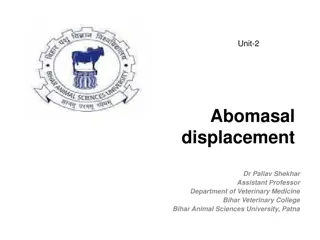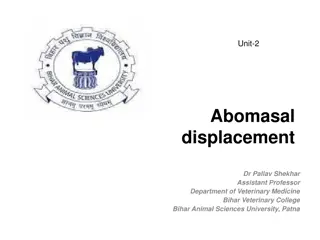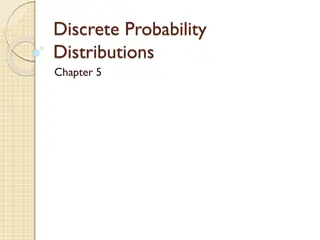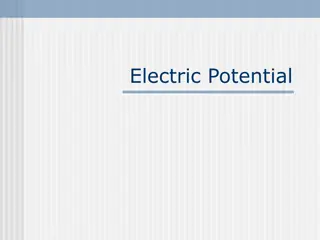Understanding Electric Displacement in Dielectrics and Charge Distributions
Electric displacement in dielectrics involves the interaction of external fields, induced fields, and bound charges, leading to the total electric field. The concept is further explored in contexts like linear dielectrics, dielectric spheres, and charge distributions in solid dielectric rods. Key equations and relationships are discussed to enhance understanding of electric displacement phenomena.
Download Presentation

Please find below an Image/Link to download the presentation.
The content on the website is provided AS IS for your information and personal use only. It may not be sold, licensed, or shared on other websites without obtaining consent from the author. Download presentation by click this link. If you encounter any issues during the download, it is possible that the publisher has removed the file from their server.
E N D
Presentation Transcript
If you put a dielectric in an external field Eext, it polarizes, adding a new field, Einduced (from the bound charges). These superpose, making a total field Etot. What is the vector equation relating these three fields? Etot+Eext+Einduced=0 B) Etot=Eext+Einduced E) Something else! Etot=Eext-Einduced Etot=-Eext+Einduced A) C) D)
We define "Electric Displacement" or "D" field: D = 0E + P. If you put a dielectric in an external field Eext, it polarizes, adding a new field, Einduced (from the bound charges). These superpose, making a total field Etot. Which of these three E fields is the "E" in the formula for D above? A) Eext B) Einduced C) Etot
Linear Dielectric: P=e0ceE ce is the Electric Susceptibility (Usually small, always positive)
Linear Dielectric: P=e0ceE is the Electric Susceptibility =e0E+e0ceE =e0(1+ce)E ce D=e0E+P e0erE eris the dielectric constant e e0eris the permittivity
We define D =0E + P, with D da A point charge +q is placed at the center of a dielectric sphere (radius R). There are no other free charges anywhere. What is |D(r)|? = Qfree, enclosed R + +q A) q/(4 r2) everywhere B) q/(4 0 r2) everywhere C) q/(4 r2)for r<R, but q/(4 0 r2)for r>R D) None of the above, it's more complicated E) We need more info to answer!
A solid non-conducting dielectric rod has been injected ("doped") with a fixed, known charge distribution (s). (The material responds, polarizing internally) When computing D in the rod, do you treat this (s) as the "free charges" or "bound charges" ? A) "free charge" B) "bound charge" C) Neither of these - (s) is some combination of free and bound D) Something else. (s)
A very large (effectively infinite) capacitor has charge Q. A neutral (homogeneous) dielectric is inserted into the gap (and of course, it will polarize) . We want to find D everywhere. Which equation would you head to first? i) D = e0E + P ii) D da iii) E da +Q B =Qfree =Q/e0 + B -Q A) i B) ii C) iii D) More than one of these would work OK.
An ideal (large) capacitor has charge Q. A neutral dielectric is inserted into the gap (and of course, it will polarize) We want to find E everywhere (i) D = 0E + P (ii) +Q B + B D d E d A =Qfree A =Q/e0 (iii) -Q Which equation would you go to first? A)i B) ii C) iii D) Your call: more than 1 of these would work! E) Can't solve, unless know the dielectric is linear!
Linear Dielectric: P=e0ceE D=e0E+P =e0(1+ce)E ce is the Electric Susceptibility e0erE eris the dielectric constant
An ideal (large) capacitor has charge Q. A neutral lineardielectric is inserted into the gap. We want to find D in the dielectric. = + D d a Q free B + B For the Gaussian pillbox shown, what is Qfree,enclosed? A) D) ( + B) E) Something else B) B C) ( B)
An ideal (large) capacitor has charge Q. A neutral lineardielectric is inserted into the gap. We want to find D in the dielectric. = + f D d a Q free B + B For the Gaussian pillbox shown, what is Qfree,enclosed? f A) f B) B C) ( f B) D) ( f+ B) E) Something else
MD8-4 An ideal (large) capacitor has charge Q. A neutral lineardielectric is inserted into the gap. We want to find D in the dielectric. = + f D d a Q free B + B Is D zero INSIDE the metal? (i.e. on the top face of our cubical Gaussian surface) f A) It must be zero in there B) It depends C) It is definitely NOT zero in there
An ideal (large) capacitor has charge Q. A neutral lineardielectric is inserted into the gap. We want to find D in the dielectric. = + f D d a Q free B + B f What is |D| in the dielectric? A) f B) 2 f C) f / 2 D) f + b E) Something else
An ideal (large) capacitor has charge Q. A neutral linear dielectric is inserted into the gap. Now that we have D in the dielectric, what is E inside the dielectric ? +Q B A) E = D r B) E = D/ 0 r C) E = D D) E = D/ ) Not so simple! Need another method + B -Q
Linear Dielectric: D=e0erE eris the dielectric constant
An ideal (large) capacitor has charge Q. A neutral linear dielectric is inserted into the gap (with given dielectric constant) Now that we have D in the dielectric, what is E in that small gapabove the dielectric ? +Q B A) E = D r B) E = D/ 0 r C) E = D D) E = D/ ) Not so simple! Need another method + B -Q
An ideal (large) capacitor has charge Q. A neutral lineardielectric is inserted into the gap (with given dielectric constant) Where is E discontinuous? +Q B i) near the free charges on the plates ii) near the bound charges on the dielectric surface + B -Q A) i only B) ii only C) both i and ii (but nowhere else) D) both i and ii but also other places E) none of these/other/???
An ideal (large) capacitor has charge Q. A neutral linear dielectric is inserted into the gap (with given dielectric constant) Where is E discontinuous? i) near the free charges on the plates ii) near the bound charges on the dielectric surface +Q B + B -Q A)i only B) ii only C) both i and ii (but nowhere else) D) both i and ii but also other places E) none of these/other/???
An ideal (large) capacitor has charge Q. A neutral linear dielectric is inserted into the gap (with given dielectric constant) Where is D discontinuous? i) near the free charges on the plates ii) near the bound charges on the dielectric surface +Q B + B -Q A)i only B) ii only C) both i and ii (but nowhere else) D) both i and ii but also other places E) none of these/other/???
A point charge +q is placed at the center of a neutral, linear, homogeneous, dielectric teflon shell. Can D be computed from its divergence? D da =Qfree A)Yes B)No C) Depends on other things not given + q
A point charge +q is placed at the center of a neutral, linear, homogeneous dielectric teflon shell. The shell polarizes due to the point charge. Is the curl of the polarization P zero everywhere? P dl =0 for every possible loop? A)Yes B)No C)Depends on other things not given + - + - + + - - + + - q - - + + - +
A point charge +q is placed at the center of a neutral, linear, dielectric hemispherical shell. Can D be computed from its divergence? D da =Qfree A)Yes B)No C)Depends on the inner radius of the dielectric. + q
MD8-8 A point charge +q is placed at the center of a neutral, linear, dielectric shell. The shell polarizes due to the point charge. Is the curl of the polarization P zero everywhere? P dl A)Yes B)No C)Depends on the inner + + - - =0 for every possible loop? + + + - - - radius of the dielectric. + q
MD8-9 An infinite plane of charge with surface charge density f is between two infinite slabs of neutral linear dielectric (of dielectric constant r), as shown. The "bare" E-field, due only to the plane of free charge, has magnitude Eo = f / 2 0 X E = ? + + + + + + + + + + + + + + + + + + + + + + + + + + + + + + + f What is the magnitude of the E-field in the space above the top dielectric at the point x ? A) E = E0 B) E > E0 C) E < E0
4.11 We argued that C goes UP by a factor of r if you fill a capacitor with dielectric. What happens to the stored energy of a capacitor if it s filled with a dielectric? A) It goes up B) It goes down C) It is unchanged D)The answer depends on what else is held fixed (V? Q?)
4.12 b If we push this dielectric inside the isolated capacitor, will it be drawn into the capacitor or repelled? DIELECTRIC A.It gets sucked into the capacitor B.It gets pushed out from the capacitor C.I just don t know.























